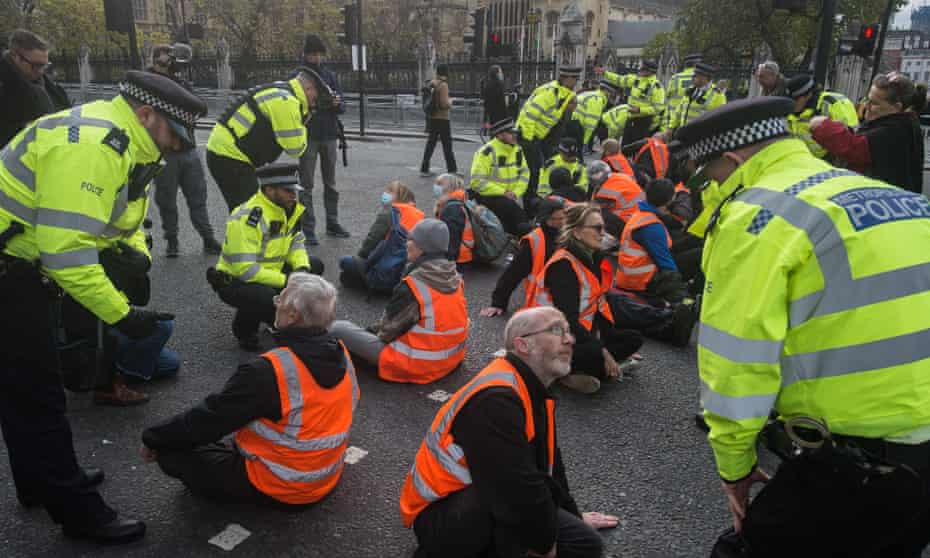Extract from The Guardian
Non-violent civil disobedience remains a vital tool for protest, but its form is shifting.

Insulate Britain protesters – who ‘barged into the public’s consciousness’ – glued their hands to the road near London’s Parliament Square in November.
Last month, nine activists were sent to prison, where one of them, a scientist called Emma Smart, went on hunger strike for 26 days. Marches and rallies have been linked to protest since the middle ages. The Extinction Rebellion (XR) network, of which Insulate Britain is an offshoot, revived the tradition of getting arrested on purpose, a tactic employed by suffragettes. The idea is that by peacefully inundating the forces of law and order while attracting strong public support for a just cause, pressure can be put on the state to force change.
Two and a half years ago, the first wave of occupations of London landmarks by XR resulted in parliament voting to declare a climate emergency – meeting one of the rebels’ key demands. This coincided with a groundswell of support for the school strike movement, launched the previous year by Greta Thunberg in Stockholm.
Anti-protest amendments
The extent to which environmental activism becomes more difficult in 2022 will depend in part on the law, the courts and public opinion. Labour has yet to announce whether it will vote against a raft of anti-protest amendments added to the government’s police bill in the House of Lords. This repressive piece of legislation is the strongest anti-activist statement yet from a government whose leader once said that he would lie down in front of the bulldozers himself to stop a third runway at Heathrow airport being built.
It is for the judges to determine what the law is. In June, the supreme court quashed the conviction of four anti-arms trade activists, in a ruling with wider ramifications that said some “disruption of ordinary life” is acceptable if caused by people exercising their right to free expression. The public mood creates the context in which all sorts of decisions (by politicians, prosecutors, businesses) are made. Evidence shows that the British public is increasingly alarmed about the climate: in October, Ipsos Mori found that 80% believe it is a global emergency caused by humans. But activists are divided about how best to harness such attitudes in order to drive the kinds of emissions reductions that are so desperately needed.
There have always been differences in an environmental movement that spans a huge range of interests and priorities. Previously, the most obvious dividing line was between those engaged in the kinds of civil disobedience pioneered by Greenpeace (whose first action took place 50 years ago) and those focused solely on constitutionalist methods. But as agitations have become more aggressive, divisions in the green movement have become sharper. XR deserves credit for having boosted the climate crisis to the top of the political agenda – before the pandemic interrupted. But the theory of change it adopted, that if 3.5% of a population becomes engaged in non-violent direct action then a campaign will succeed, has been criticised as simplistic. An angry, physical confrontation with rush-hour passengers in east London is widely seen as a serious mistake, and suggestive of a worrying blindness to the social injustice and inequality that are an essential dimension of progressive climate politics, domestically and internationally. Similarly, Insulate Britain has faced criticism from those who think that the tactic of deliberately creating traffic jams is counterproductive – potentially making it easier for the government to pass laws restricting the right to protest.
Feasible tactics
Another argument concerns who or what should be the target of protests. Given the failure of governments to rise to the challenge, both individually and collectively via the UN, some activists now believe that their efforts should be focused elsewhere. The US environmental writer and activist Bill McKibben thinks campaigners should ramp up pressure on the banks that finance fossil fuels. The question of how much emphasis to put on behaviour change in the rich western countries with the highest per capita emissions also remains contentious. The British philosopher Rupert Read, who has acted as a spokesperson for XR, argues that greater efforts within communities are a constructive way to make emissions reductions happen.
Politics in the traditional sense remains vital, particularly in countries where 2022 will see important elections. Brazil’s citizens would do the world a favour by rejecting its climate-denying president. Non-violent civil disobedience erases the line between compliance and resistance to the state. In countries that abide by democratic principles, it remains a feasible tactic to challenge policies while accepting a system’s fundamentals. However, the existential nature of climate change leads to questions about the latter.
Louise Lancaster, a former teacher and Insulate Britain protester, told the Guardian in November that she would be “willing to die” for the cause if she thought that it might save her three children from climate-related deaths. In his provocatively titled book How To Blow Up a Pipeline, the Swedish activist Andreas Malm makes a case for sabotaging fossil fuel infrastructure. Yet eco-sabotage could harden rather than soften climate-sceptic attitudes, making it easier for states to respond harshly. Non-violence does not seek to undermine the rule of law, only the repeal of unjust laws. Ultimately, it’s difficult to see how a just transition to net zero could be achieved by unjust means.
No comments:
Post a Comment